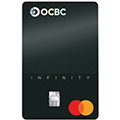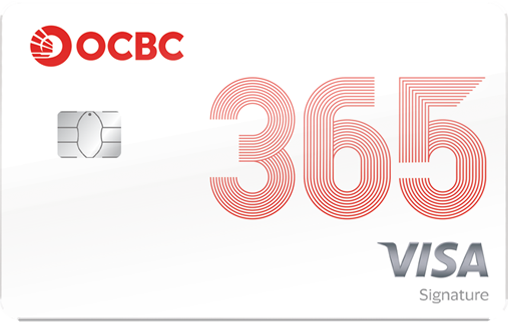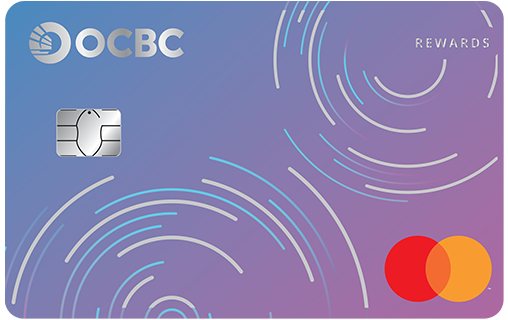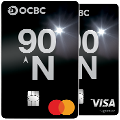Canola Oil, Olive Oil, Soybean Oil, Is There A Difference?
Canola Oil, Olive Oil, Soybean Oil, Is There A Difference?
Know the oily truth to make a healthier choice in your cooking
Ever felt overwhelmed by the variety of cooking oils in the supermarket aisle? With so many options, it is difficult to decide on the best. You’re likely to just pick up a familiar bottle and continue on your way.
We’ve put together a simple guide to demystify the process and help you choose a cooking oil to prepare healthier meals for your family.
The Facts About Fat
First, the bad news: all cooking oil is 100% fat. The term healthy cooking oil is very much a misnomer. Hence, like sugar, oil should be used sparingly.
While oil is 100 percent fat, there are good and bad fats:
- Good fats refer to monounsaturated and polyunsaturated fats, which lower LDL (bad) cholesterol.
- Bad fats refer to trans fat and saturated fat, which lower HDL (good) cholesterol levels and raises LDL levels.
As a rough guide, choose oil that contains no more than 35 percent of saturated fat, less than 0.5 percent of trans fat and more than 50 percent of unsaturated fat (as indicated on the Nutritional Information labels). Sounds easy enough? But wait, there’s more.
Related: Introduction to Fats
What is Smoke Point?
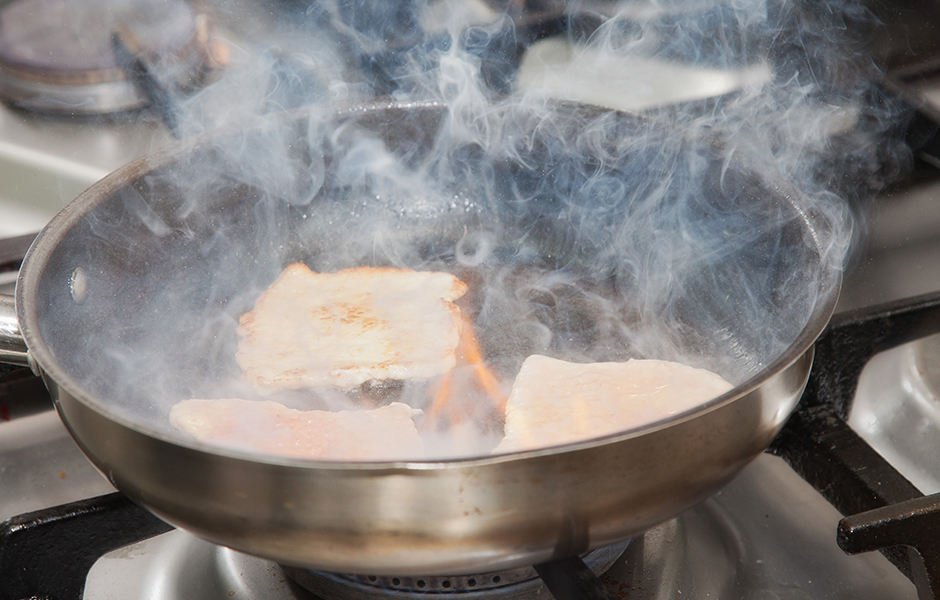
Smoke Point is the temperature at which oil breaks down and burn, giving food an unpleasant burnt taste. In the process, free radicals harmful to your body are released.
Cooking oils have different smoke points. For example, olive oil, which has gradually found its way into the Singaporean kitchen, has a relatively low smoke point of 199 °C. Although olive oil is widely hailed as a healthy and flavourful option, it is not suitable for high-heat cooking.
So, for deep-frying (from 177 to 232 degrees Celsius) and baking at high temperatures, use oils with higher smoke points.
Different Oils for Different Foods
It is good to have different types of oil in your kitchen for different uses such as drizzling on salads, light cooking or deep-frying. Here is a list of the more common cooking oils available and what they are suitable for.
- Canola Oil — Canola has a high content of unsaturated fats, which makes it a healthier choice. It also contains omega-3 and omega-6 fatty acids. Its non-distinctive flavour makes it suitable for general cooking, but avoid using it for deep-frying as it has a relatively low smoke point of 204 °C.
- Olive Oil (Extra Virgin) — Extra virgin olive oil is flavourful and ideal for enhancing the taste of food. High-quality olive oils tend to be expensive, hence it is better used for drizzling over salads, raw foods or as a flavour enhancer.
- Olive Oil (Extra Light) — Not to be confused with extra virgin olive oil or pure olive oil, extra light olive oil has a lighter flavour and a high smoke point (242 °C), which make it suitable for most cooking methods.
- Peanut Oil — This golden oil is also commonly known as groundnut oil. It has a thin consistency, bland flavour (ideal for cooking) and a high smoke point of 232 °C.
- Rice Bran Oil — Its high smoke point (254 °C) and neutral taste make it a good choice for deep-frying and stir-frying.
- Soybean Oil — Soybean oil is low in saturated fat and high in unsaturated fats. Its high smoke point (256 °C) and inexpensive price make it ideal for deep-frying.
- Sesame Oil — Relatively low in saturated fat, sesame oil is most commonly used as a flavour enhancer rather than a cooking oil. This is largely due to its distinctively nutty aroma and higher price.
- Sunflower Oil — Sunflower oil is predominantly made up of polyunsaturated fats. Its relatively inexpensive price and smoke point of 227 °C make it suitable for daily cooking and frying applications.
Related: Getting the Fats Right!
How to Store Cooking Oil
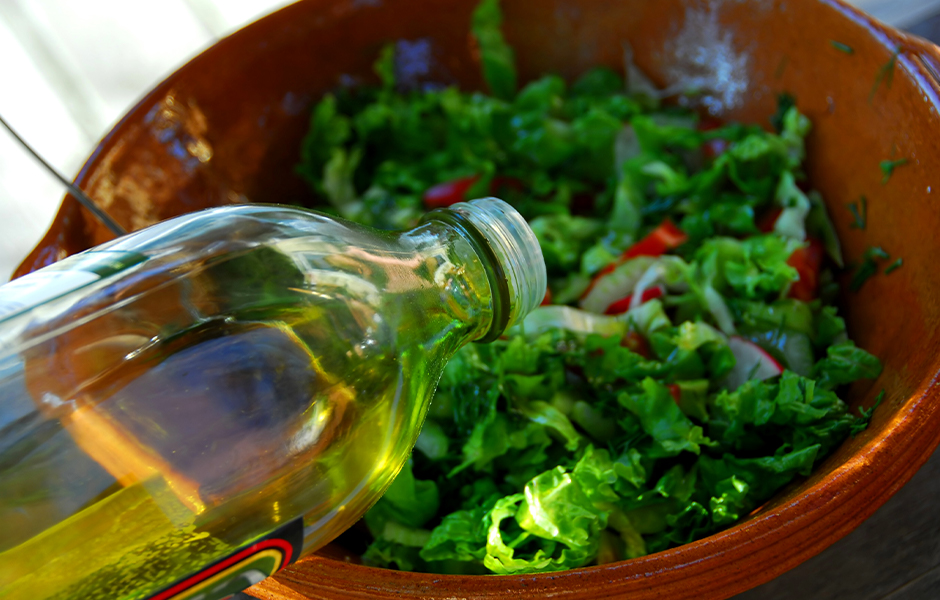
While unsaturated fats are generally better for our bodies, they are prone to oxidisation (reacting with oxygen) and turning rancid. As a general rule, oils that contain more saturated fat, which are less healthy, have the longest shelf life, followed by monounsaturated then polyunsaturated.
Here are a few helpful tips on storing oil:
- Keep the lid tightly closed to reduce exposure to oxygen.
- Store cooking oils in a cool, dark cupboard.
- If you keep oil on your countertop, consider using dark-coloured bottles to reduce exposure to heat from sunlight.
- Avoid keeping cooking oils in iron or copper containers as they can react with the metals making it unsafe to consume.
- Take note of the recommended shelf life for various cooking oils: olive oil (15 months), peanut oil (2 years), rice-bran, soybean, and sunflower oil (1 year), and sesame oil (6 months).
- For longer storage periods, you can refrigerate cooking oil. You should, however, leave them at room temperature for one to two hours for the oil to return to its regular consistency.
- If oil is seldom used in your home cooking, purchase smaller bottles of oil (e.g. 250ml) to avoid lengthy storage times.
Related: Trim the Fat
What If You Eat Out?
Although you can’t control the type of oil used outside, you can dine at more than 2,900 food eateries that use healthier oil, which has no more than 35 percent saturated fat and 0.5 percent trans fat. Simply look out for stalls that carry the healthier oil decal.
Oil’s Well That Ends Well
In conclusion, follow the guidelines below when choosing your next bottle of cooking oil:
- It should contain less than 35 percent saturated fat, more than 50 percent unsaturated fat and less than 0.5 percent of trans fat. Look out for the Healthier Choice Symbols indicating which oil is “Trans Fat Free” or “Lower in Saturated Fat”.
- Take note of the smoke point of different oils when choosing which to use for deep frying, sautéing or drizzling over salads.
- Store your oils properly using the recommended storage periods, as oil deteriorates over time.
Read these next:
- Happy with Healthier Food
- 5 Healthier CBD Lunchtime Dining Options
- Restaurant Guide to Healthier Eating
Did you find what you were looking for?
That's great! Is there anything else you would like to share?
Did you find what you were looking for?
This is embarrassing! How can we improve your experience?
An error occurred. Please check that you have input the correct information before re-submitting.
We are unable to capture your message at the moment. Please try again shortly.
Thank you for your feedback.
This will help us serve you better.


